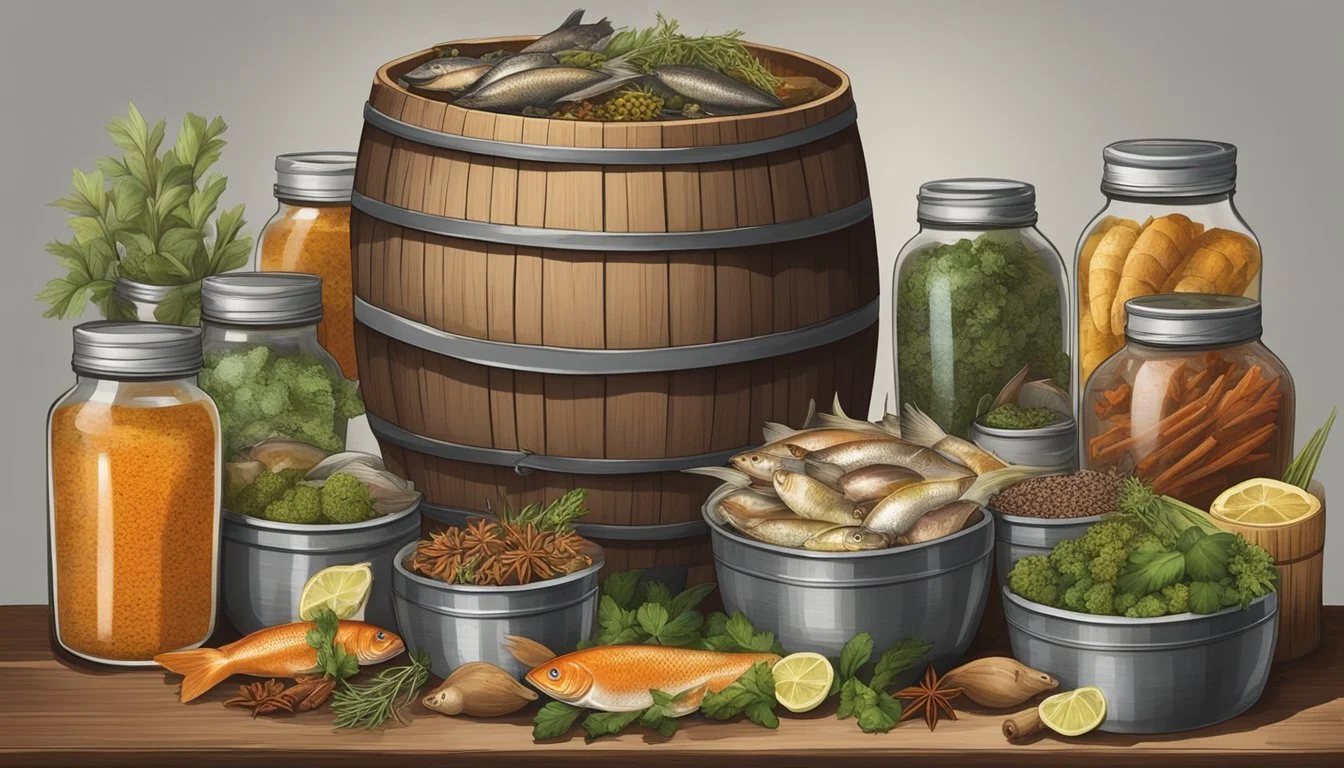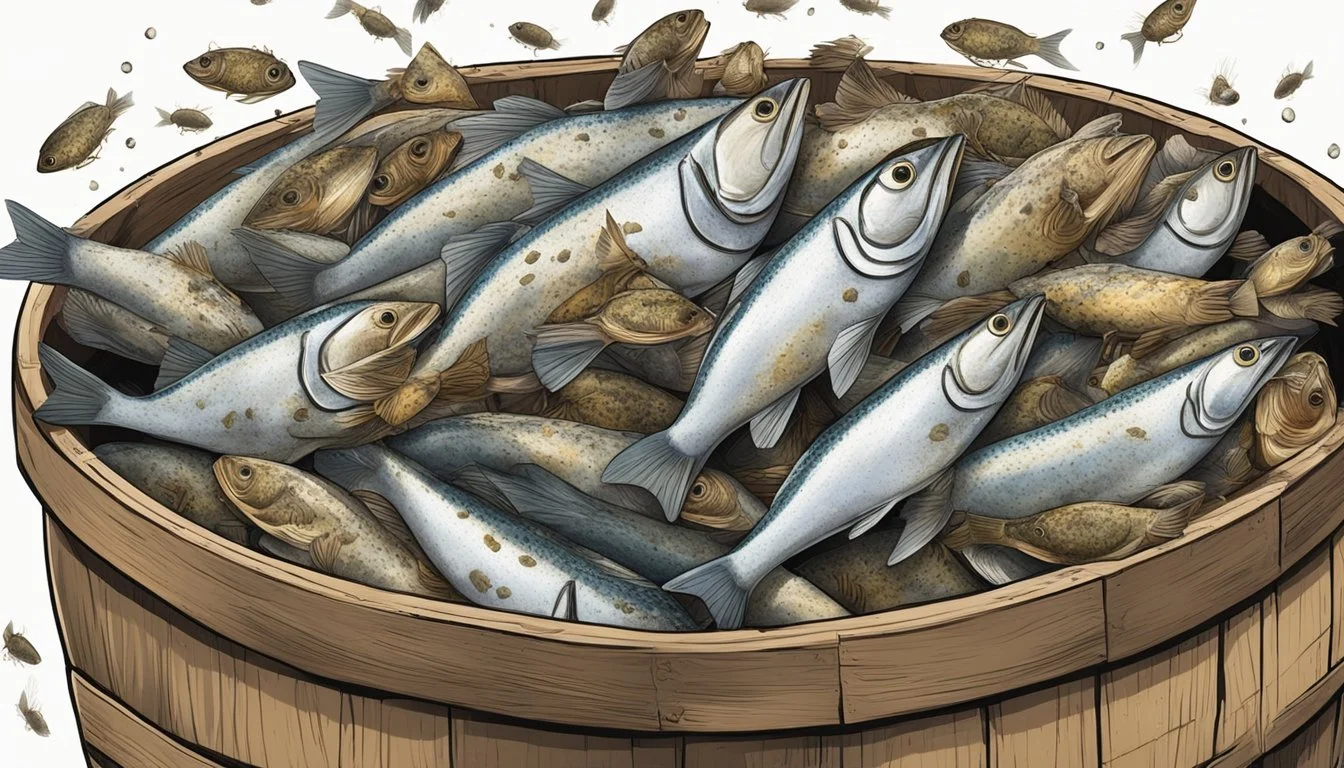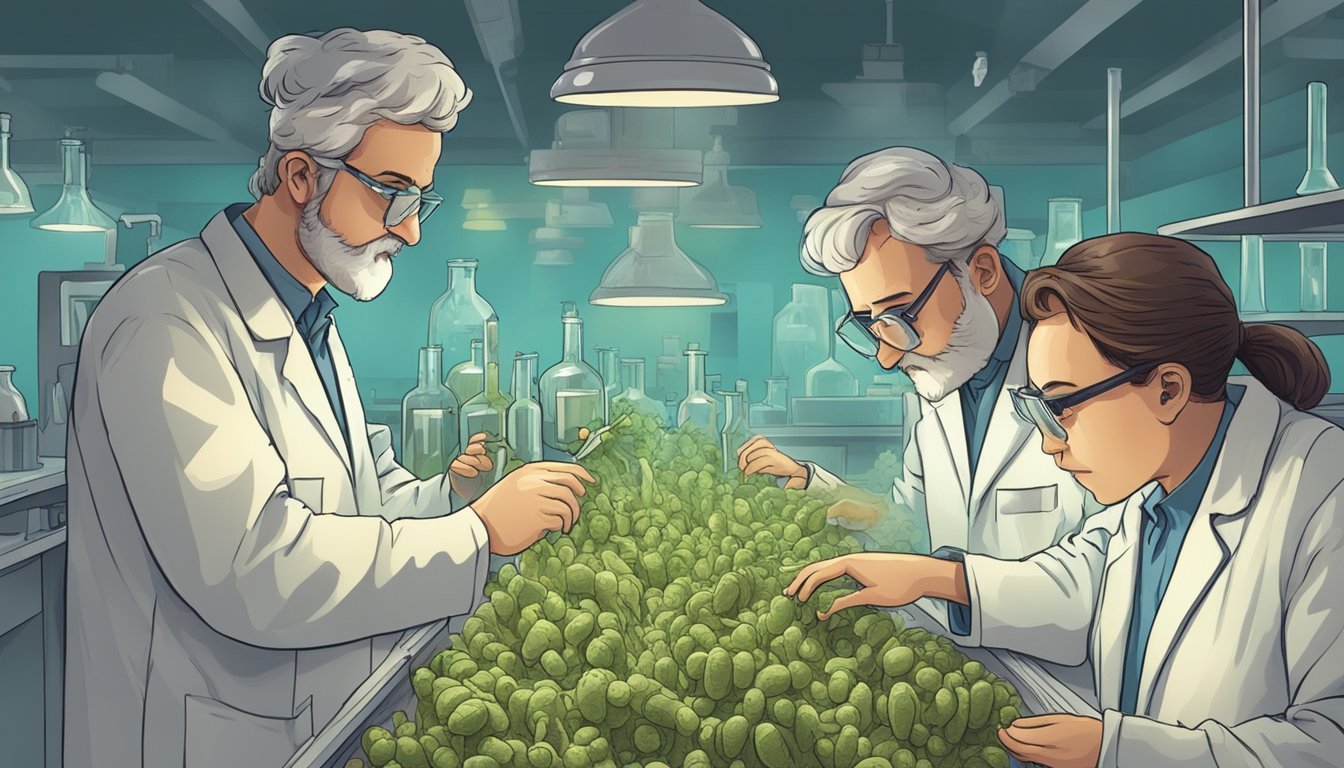Stinkheads
Unwrapping Alaska's Traditional Fermented Delicacy
Stinkheads, a traditional dish revered by many in Alaska, are fermented fish heads known for their distinctive aromatic intensity. This unique delicacy hails from the Inuit culture and features prominently in the culinary traditions of the Yukon-Kuskokwim Delta communities. With a preparation process that involves fermentation—a method historically used to preserve food—these foods are a testament to the resourcefulness of indigenous Alaskan practices.
The art of making stinkheads begins with the careful selection of fish, usually salmon, (What wine goes well with salmon?) though other fish species may also be utilized. The heads of these fish, once removed, are buried underground, traditionally in wooden barrels covered with burlap, to naturally ferment for several weeks or even months. This method transforms the fish heads, intensifying their flavors and creating the pungent kick for which they are named.
Cultural significance aside, stinkheads offer a glimpse into the diverse culinary techniques that have developed over millennia in response to environmental conditions and preservation needs. Today, while the traditional method of fermenting in barrels may have given way to the use of plastic bags and buckets, the essence of stinkheads remains a beloved continuation of Alaskan heritage.
Historical Significance and Origins
Stinkheads are a potent testimony to the resilience and ingenuity of Arctic Indigenous peoples, encapsulating the fusion of tradition and local resources found in southwest Alaska.
Inuit Traditions and the Yupik People
The Inuit and Yupik people, indigenous to southwest Alaska, have long relied on the bounty of the rivers and seas to sustain their communities. Stinkheads, fermented fish heads, particularly salmon, have been a cornerstone of their traditional diet. This unique form of Arctic cuisine is born out of necessity and the wisdom of traditional knowledge, essential for survival in the harsh climate.
To create stinkheads, Inuit and Yupik methods involve wrapping salmon heads — often accompanied by guts — in local plant materials or storing them in containers, and then allowing them to ferment naturally by burying them in the ground. This process is carried out post-summer hunting and fishing season, aligning with the traditional knowledge of food preservation in an environment where fresh food is scarce for much of the year.
The practice has not only provided sustenance but also represents a cultural heritage intrinsic to the Yupik and an expression of respect for the sustenance the animals provide. Despite the strong odor that the name implies, stinkheads are a cherished dish, offering a direct connection to the past and a living continuity of age-old customs within the community.
Preparation Methods
As a time-honored method of preserving fish, stinkheads are prepared through a controlled fermentation process that transforms fish heads into a traditionally consumed delicacy in Alaska.
Traditional Practices
Historically, the Indigenous peoples of southwest Alaska prepare stinkheads by placing salmon heads—often along with the guts—into a wooden barrel. To facilitate the fermentation process, the barrel is then covered with burlap to create an anaerobic environment, essential for preserving the fish without spoilage from oxygen. They then bury this setup in the ground, allowing the natural fermentation to occur over the course of about a week. During this time, beneficial bacteria break down the fish heads, producing the characteristic pungent odor and unique flavor. Occasionally, seal oil is added to the mix to introduce additional flavors and aid in the preservation.
Modern Adaptations
In contemporary times, traditional elements like the wooden barrel have been replaced with readily available plastic bags or buckets. These modern containers still permit an anaerobic environment critical for fermenting the fish heads. The use of plastic also makes the process more accessible and convenient, as these materials are easier to handle and obtain. Despite these modern adaptations, the fundamental principles of the practice remain consistent with the traditional methods, retaining the cultural significance and culinary profile of the classic dish.
Culinary Uses and Recipes
Stinkheads, known as tepa to the Yupik, are a traditional Alaskan delicacy made from fermented fish heads, typically salmon or herring. This section explores the role of stinkheads in indigenous cuisine and offers guidance on how to serve this unique dish.
Stinkheads in Yupik Cuisine
In Yupik culture, stinkheads serve not only as food but also as a connection to ancestral culinary practices. To prepare stinkheads, they traditionally wrap salmon heads and guts in burlap, then bury them in the ground for approximately seven days to allow fermentation. Today, burlap is often substituted with plastic bags or buckets.
Preparation Steps:
Clean the salmon heads and remove the gills.
Place in a fermentation vessel, such as a wooden barrel or a food-safe plastic bag.
Cover with burlap (traditionally) or seal the container.
Bury underground for a period, commonly one week, depending on the temperature.
Unearth and check if the fish heads have fermented to the desired level.
Serving Suggestions and Accompaniments
When it comes to serving stinkheads, they are typically eaten as is, without the need for elaborate preparation post-fermentation. Their strong, distinct flavor means they are often paired with simpler foods to balance the taste.
Accompaniments:
Boiled: They may be boiled to mellow out the intense flavor.
Dried fish: Serve alongside dried fish for varied texture.
Akutaq: Sometimes paired with Eskimo ice cream, a concoction of whipped fat, berries, and sometimes sugar.
Condiments: Simple condiments like salt may be used, but they are often enjoyed without to appreciate the full flavor profile.
Remember, stinkheads represent a cherished food tradition that has been passed down through generations, offering a pungent but appreciated taste of Alaska's indigenous heritage.
Health and Nutrition
The nutritional benefits and risks associated with Alaskan fermented fish heads, or 'stinkheads,' are a subject of interest to many. While they provide significant nourishment, they also carry health risks that require diligent attention.
Nutritional Content
Fermented fish heads, commonly consumed as part of the Alaskan Native diet, are a source of various important nutrients. Stinkheads contain proteins which are essential for body repair and growth. They also offer a good amount of fats, which can provide a concentrated source of energy. Since these fish heads are part of the whole fish, they also include vitamins and minerals that are essential for maintaining good health, including vitamin A, vitamin D, omega-3 fatty acids, iron, zinc, and calcium.
Protein: Vital for repair and muscle growth
Fat: Provides energy; contains omega-3 fatty acids
Vitamins: Vitamin A and D presence
Minerals: Include iron, zinc, and calcium
Health Risks and Botulism Concerns
Despite their nutritional value, stinkheads pose a risk of botulism, a severe and potentially fatal illness caused by the botulinum toxin. Fermented foods, (What wine goes well with fermented foods?) in general, can serve as a breeding ground for the bacteria Clostridium botulinum if not prepared correctly. In Alaska, there have been more than 350 documented cases of botulism from 1950-2017, linked to traditional fermented foods like stinkheads. The symptoms of botulism include weakness, dizziness, double vision, and trouble speaking or swallowing.
Botulism Toxin: Can lead to severe symptoms and fatality
Fermented Foods Risk: Improper fermentation can cause Clostridium botulinum growth
Outbreaks: Documented cases highlight the need for careful food preparation
Symptoms: Include neurological impairments such as weakness and double vision
It is crucial for the preparation of stinkheads to be meticulously managed to prevent an outbreak of botulism. The consumption of stinkheads must be approached with a balance of tradition and safety, ensuring that these foods are both nutritious and safe to eat.
Cultural Impact and Regional Variations
Stinkheads, fermented fish heads, are a traditional Alaskan delicacy with profound cultural significance and distinct regional preparations among Alaskan communities.
Significance in Alaskan Communities
In Western Alaska and particularly the Yukon-Kuskokwim Delta, stinkheads hold a place of esteem at the dinner table. They are more than just a source of sustenance; they are a living heritage, reflecting the resiliency and resourcefulness of Alaskan Natives. Surrounded by the harsh natural elements, Alaskan communities, including those in rural areas, have historically relied on these types of fermented foods to sustain them through the frigid winters. Today, they continue to be a vital element of social gatherings and feasts, symbolizing a connection to ancestral dietary practices.
Variations Across Alaska
Regional variations of this delicacy are influenced by environmental conditions and cultural preferences. In the north, the tradition of fermenting fish heads often incorporates burbot and other available species, while the communities closer to Anchorage might have a different approach to fermentation given their relatively easier access to varied resources. Throughout Rural Alaska, the methods of preparing stinkheads can vary, with some burying them in the ground for fermentation while others might use wooden barrels. Regardless of the method, the process is an art passed down through generations, with each region in Alaska adding its own touch to the practice.
Conservation and Sustainability
The production of stinkheads, a traditional Alaskan delicacy, intersects with contemporary environmental and sustainability concerns, particularly in relation to fishing practices and the impact these practices have on marine ecosystems.
Fishing and Environmental Concerns
Fish Populations: In Alaska, species such as salmon, herring, and whitefish not only provide sustenance for local communities but also play crucial roles in the marine ecosystem. Overfishing of these species can disrupt the ecological balance, potentially affecting other marine mammals and the health of the oceans.
Bycatch: Bycatch, the capture of unintended species such as marine mammals and birds, poses an additional threat to marine life during fishing operations.
Habitat Disruption: Destructive fishing practices can damage the underwater habitats, which are vital for the survival of various fish species and their reproductive processes, including spawning grounds for salmon and herring.
Sustainable Fishing Practices
Regulation and Quotas: Responsible fishing practices, enforced through regulation and quotas, aim to ensure that fish populations, including salmon and whitefish, remain at sustainable levels. This is essential for the continuity of stinkhead production and for the health of the wider marine ecosystem.
Selective Gear: The adoption of selective gear that reduces bycatch ensures targeted fishing and minimizes harm to non-target species.
Habitat Protection: Protection measures for critical habitats, like spawning areas for salmon, are an integral part of sustainable fishing strategies.
Aquaculture: In some cases, fish farms for species like salmon and roe production can alleviate pressure on wild populations while providing a controlled environment for food production. However, this must be carefully managed to prevent pollution and disease that could impact wild counterparts.
Scientific Studies and Research
This section delves into the meticulous analysis and findings from scientific investigations surrounding the traditions and implications of fermented fish, particularly 'stinkheads'.
Fermentation Science
Fermentation in fish involves the breakdown of complex organic compounds by microorganisms under anaerobic conditions, producing a distinctive taste and aroma. Stinkheads, a term for fermented fish heads commonly consumed in Alaska, are an excellent case study in fermentation science. Researchers identify that lactic acid bacteria play a crucial role in this fermentation process, enhancing the preservation of the fish through the production of lactic acid, which lowers the pH. Additionally, protein breakdown during fermentation is significant, altering the texture and flavor profile of the fish.
A core concern in the fermentation of fish heads is the potential growth of Clostridium botulinum, the bacteria responsible for botulism. The risk is linked to the traditional preparation and fermentation methods which take place in environments conducive to the bacteria's growth, such as oxygen-poor and warm conditions.
University Research Findings
Studies from the University of Alaska Fairbanks have been pioneering in understanding the local practices and the microbiology involved in 'stinkheads'. These efforts shed light on critical factors such as ideal fermentation conditions, bacterial diversity, and safety protocols to mitigate the risk of botulism. Research findings underscore that maintaining specific temperature controls and monitoring the pH levels during fermentation can significantly reduce the likelihood of Clostridium botulinum proliferation, promoting safe consumption.
Collaborative research initiatives continue to evaluate the protein composition post-fermentation, providing insights into nutrient retention and potential health benefits. The university's ongoing commitment to advancing food science contributes to ensuring that traditional practices such as the preparation of 'stinkheads' meet both cultural and safety standards.
Contemporary Trends and Future Outlook
In Alaska, the age-old tradition of fermenting fish heads—colloquially known as stinkheads—is experiencing a resurgence as people seek to reconnect with traditional foods. Chefs and food enthusiasts are finding creative ways to incorporate this distinctive ingredient into modern dishes, demonstrating the versatility of preserved foods.
The Revival of Ancient Foods
The demand for ancient, preserved foods in modern times is on the rise, reflecting a broader interest in traditional knowledge and sustainable food practices. Stinkheads, made by fermenting fish heads underground in fermentation pits, exemplify this trend as they represent both a method of preserving food and a cultural heritage. The knowledge of how to ferment these foods is passed down through generations, ensuring the survival of this unique culinary tradition.
Integration into Modern Cuisine
Modern Alaskan cuisine is witnessing the integration of fermented foods like stinkheads into its gastronomic repertoire, often appearing alongside fresh ingredients or as innovative condiments. Chefs are adapting fermentation techniques to suit contemporary palates while maintaining the integrity of the food's traditional roots. The inclusion of stinkheads in present-day cooking reflects a seamless blend of historical practices and culinary innovation, expanding the perception of fermented products beyond simply being a preservation method to becoming a sought-after component in high-end cuisine.
Comparative Analyses
In this section, the culinary and cultural nuances of stinkheads are compared with other fermented foods, alongside global traditions of fermentation.
Stinkheads Versus Other Fermented Foods
Stinkheads, known as fermented fish heads, have a unique preparation method distinct from typical fermentation practices seen in other fermented seafood. They are specifically part of Alaskan Native cuisine. Unlike the pickling process where vinegar or brine inhibits bacterial growth, stinkheads are fermented naturally. They are typically made from salmon heads, which are buried underground to ferment for several weeks. This contrasts with the fermentation of foods like kimchi or sauerkraut, where additional ingredients like salt are added to promote lactic acid bacteria growth.
Tuna and other shellfish, for example, undergo distinct preservation methods such as canning or smoking, not the fermentation seen in stinkheads. The latter's fermentation is closer to that of fermented fish sauces used widely in Southeast Asia, as both rely on natural enzymatic and bacterial processes.
Global Perspectives on Fermented Delicacies
Fermented foods as a group share the trait of being preserved through the action of microorganisms such as yeast. The fermentation of stinkheads in Alaska, for instance, can be juxtaposed with the traditions of preserving muktuk—whale skin and blubber—among the Inuit. Globally, fermentation is a cornerstone in culinary traditions. In Rome, for instance, ancient roman garum, a fish sauce, was a fermenting fish-based condiment. Yet, the way stinkheads are fermented—using a cold, subterrain method—is largely unique to the colder climates of Alaska and isn't mirrored in the warmer fermentation processes utilized for European wines or Asian condiments.









